Marine Simulators Market Size
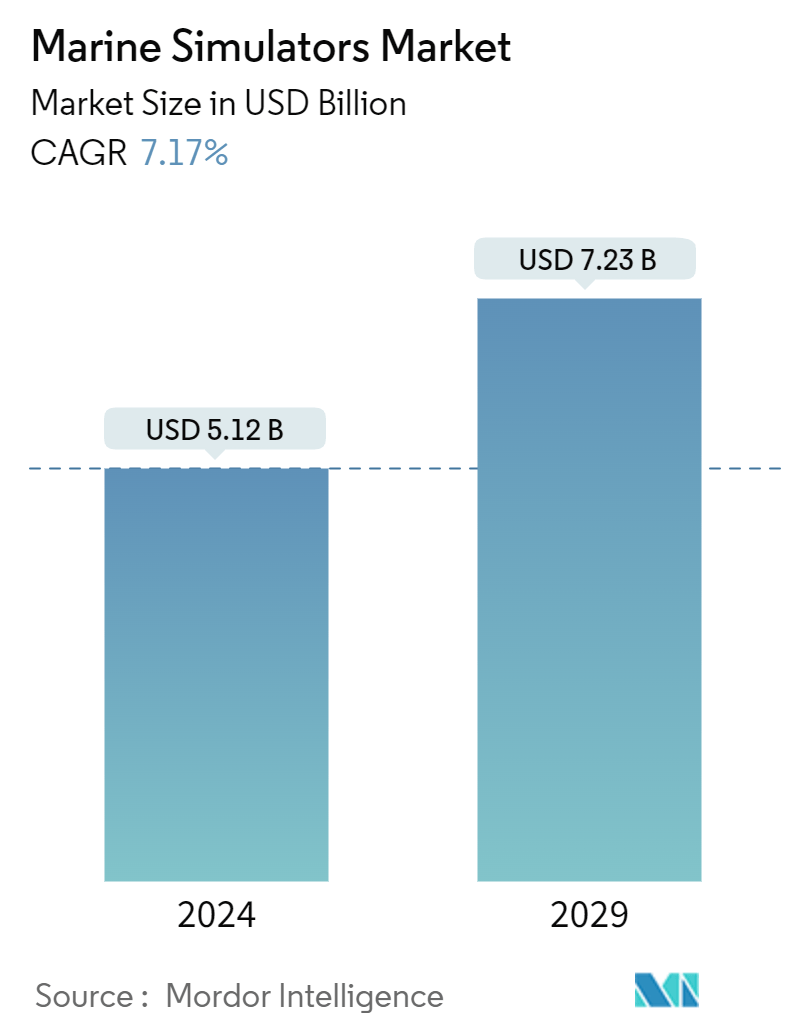
| Study Period | 2019 - 2029 |
| Market Size (2024) | USD 5.12 Billion |
| Market Size (2029) | USD 7.23 Billion |
| CAGR (2024 - 2029) | 7.17 % |
| Fastest Growing Market | Europe |
| Largest Market | North America |
Major Players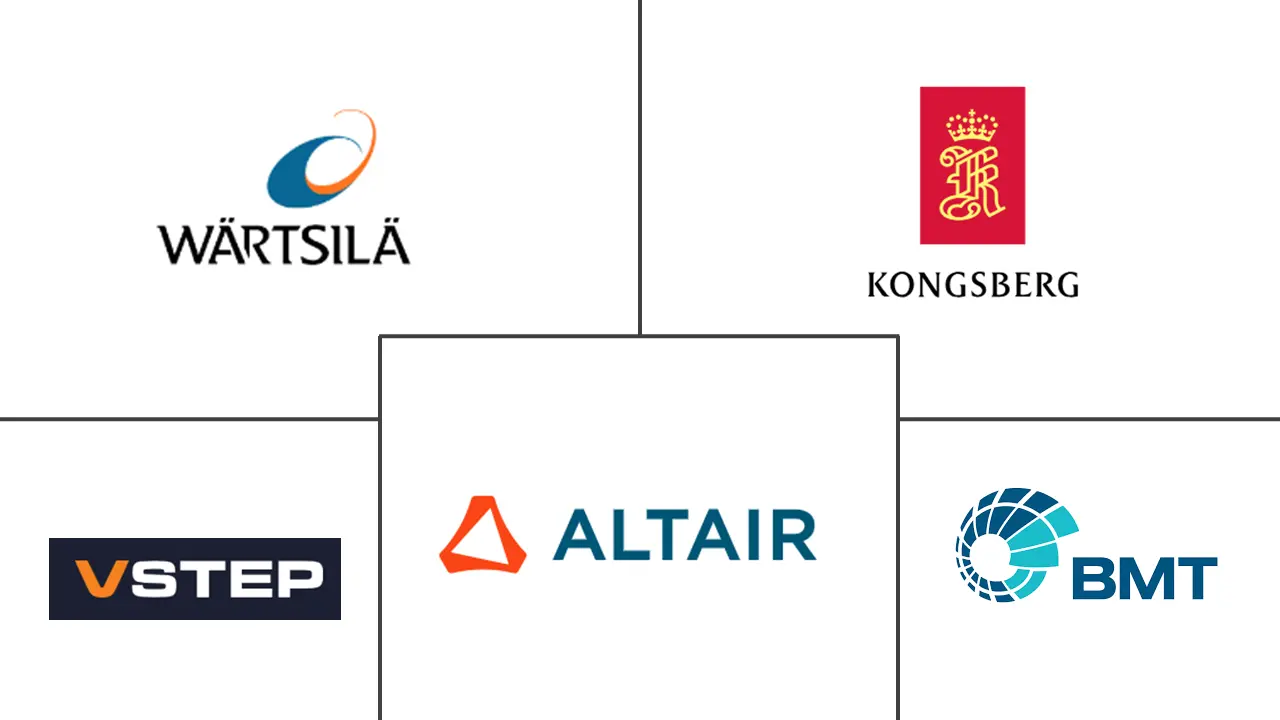
*Disclaimer: Major Players sorted in no particular order |
Marine Simulators Market Analysis
The Marine Simulators Market size is estimated at USD 5.12 billion in 2024, and is expected to reach USD 7.23 billion by 2029, growing at a CAGR of 7.17% during the forecast period (2024-2029).
Naval forces stationed at sea boundaries are pivotal in national defense, where they navigate unpredictable currents. This underscores the growing importance of training to safeguard ships and personnel. Consequently, nations such as India, China, and the United Kingdom are ramping up their use of ship simulators, fueling the marine simulators market. Modern ships feature advanced communication systems and sensors, heightening operational complexity. Consequently, training crews, maintainers, and ship operators with cutting-edge simulator solutions has become imperative to align personnel with evolving technologies.
The rising need for enhanced training to reduce offshore accidents is driving the establishment of new training facilities worldwide. In recent years, the power and transportation industries have increasingly relied on oil and gas, prompting offshore exploration giants such as ExxonMobil and Royal Dutch Shell to intensify their drilling activities. These operations, conducted beneath the seabed, are notably intricate, given the challenges posed by severe weather conditions like hurricanes and high winds. Consequently, ship operators have prioritized rigorous training. However, the high costs of manufacturing marine simulators are expected to challenge the market growth.
Marine Simulators Market Trends
The Military Segment is Expected to Showcase Significant Growth During the Forecast Period
As geopolitical tensions and marine disputes between countries increase, they strive to enhance their naval capabilities. Several countries are upgrading their existing naval fleets or replacing their aging fleets with newer-generation vessels with advanced features. With several countries increasing their defense spending over the past decade, the industry witnessed large-scale procurement and development activities.
Technological advancements also support the development of newer-generation naval vessels, as each country wants to update its maritime combat capabilities. As several countries currently operate older naval fleets, they emphasize procuring ships with the latest technologies to gain a qualitative technological edge over their adversaries. Countries worldwide are heavily investing in the development, expansion, modernization, and gradation of their existing naval fleets. Developing and procuring new naval vessels, such as frigates and submarines, are expected to generate demand for newer combat vessels. Thus, with the growing procurement of naval ships, the need for training military personnel will also increase, boosting the demand for marine simulators in the military segment.
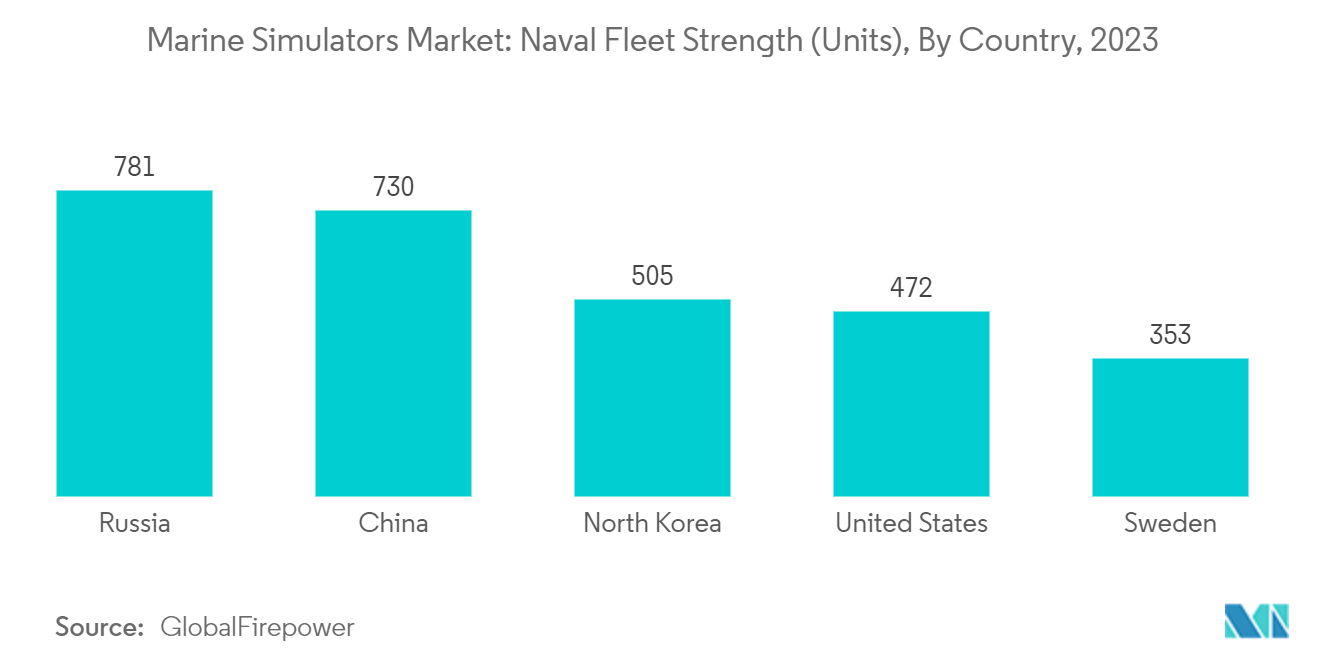
North America is Expected to Dominate the Market During the Forecast Period
North American countries, particularly the United States, boast extensive coastlines bordering the Atlantic, Pacific, and Arctic Oceans, positioning them strategically near key international waterways. Given this geography, bolstering naval capabilities becomes imperative to safeguard maritime interests and ensure regional security. Consequently, governments across North America are ramping up funding to enhance maritime officer training. In 2024, the US Department of the Navy (DON) requested a budget of USD 255.8 billion, marking a 4.5% increase from the previous year's enacted budget of USD 244.7 billion. This substantial budget increase, aimed at modernizing systems and streamlining naval training, is expected to propel North America's share in the marine simulator market.
In addition, the US Navy plans to implement force structure expansion plans and aims to reach its 355-ship goal by FY 2034 through a mix of service life extensions and new construction. Key maritime training institutes and academies nationwide have embraced cutting-edge simulators to replicate real-world scenarios for seafarers. Renowned companies offer diverse simulator solutions, from primary ship handling to sophisticated full-mission simulators, making the United States a key player in the North American maritime simulator landscape.
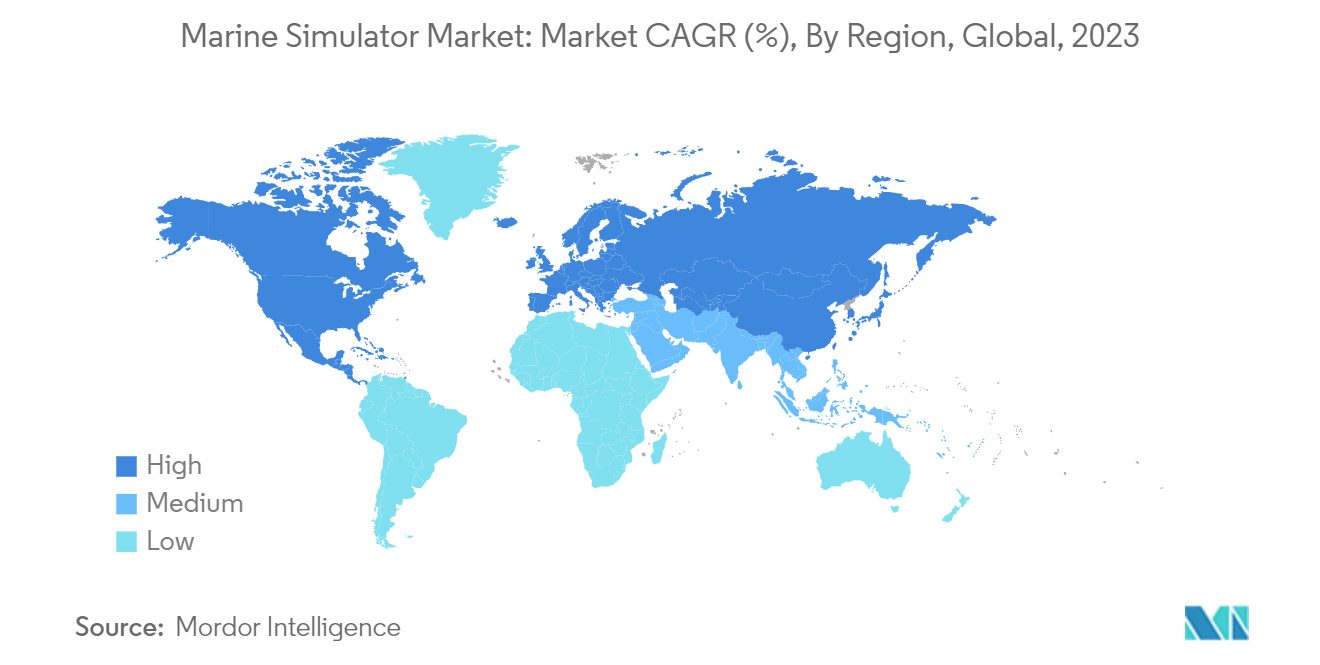
Marine Simulators Industry Overview
The marine simulators market is semi-consolidated and dominated by players such as Wärtsila Corporation, VSTEP BV, Kongsberg Gruppen ASA, Altair Engineering Inc., and BMT Group Ltd. Simulator manufacturers are required to build a brand and reach out to geographical extremes to get customers. Manufacturers may have the first-mover advantage if they can attract customers for the simulators for new vehicle platforms, as simulators tend to be reconfigured or upgraded to support newer variants, providing the players with continuous revenue inflow.
Mergers and acquisitions are expected to help the players by increasing their addressable market. For instance, in December 2022, VSTEP launched its newest maritime simulator, NAUTIS Home, to expand the accessibility of professional ship simulation. The company's goal is to increase the crucial role of simulation-based learning in maritime education and training.
Marine Simulators Market Leaders
-
Kongsberg Gruppen ASA
-
Altair Engineering Inc
-
Wärtsila Corporation
-
BMT Group Ltd
-
VSTEP B.V.
*Disclaimer: Major Players sorted in no particular order
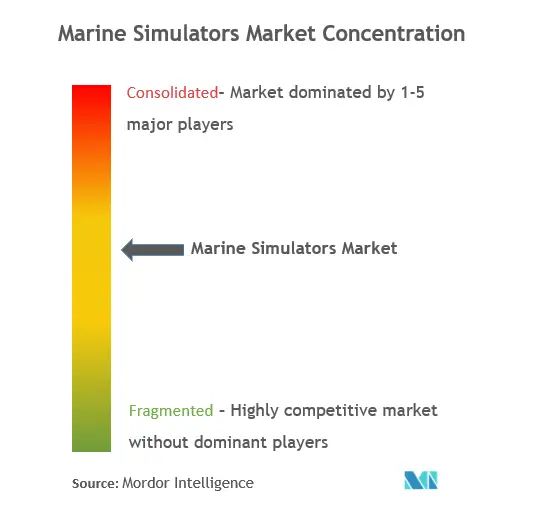
Marine Simulators Market News
January 2024: FORCE Technology was chosen to implement its SimFlex4 AR solution in a comprehensive upgrade for Smartship Australia, a Queensland maritime simulation and training facility.
May 2023: The MoD awarded BMT a hydrodynamic marine simulator training contract to provide safety, operational efficiency, readiness, and an advanced 5-bridge training platform capability in customized navigation training for the Admiralty Pilots and Tug Masters of the Queen Elizabeth-class aircraft carriers.
Marine Simulators Market Report - Table of Contents
1. INTRODUCTION
- 1.1 Study Assumptions
- 1.2 Scope of the Study
2. RESEARCH METHODOLOGY
3. EXECUTIVE SUMMARY
4. MARKET DYNAMICS
- 4.1 Market Overview
- 4.2 Market Drivers
- 4.3 Market Restraints
-
4.4 Porter's Five Forces Analysis
- 4.4.1 Threat of New Entrants
- 4.4.2 Bargaining Power of Buyers/Consumers
- 4.4.3 Bargaining Power of Suppliers
- 4.4.4 Threat of Substitute Products
- 4.4.5 Intensity of Competitive Rivalry
5. MARKET SEGMENTATION
-
5.1 By Type
- 5.1.1 Ship Bridge Simulators
- 5.1.2 Engine Room Simulators
- 5.1.3 Cargo Handling Simulators
- 5.1.4 Communication/ Global Maritime Distress and Safety System (GMDSS) Simulators
- 5.1.5 Other Types
-
5.2 By Application
- 5.2.1 Training and Education
- 5.2.2 Fleet Operations
- 5.2.3 Port and Terminal Operations
-
5.3 By End Use
- 5.3.1 Commercial
- 5.3.2 Military
-
5.4 Geography
- 5.4.1 North America
- 5.4.1.1 United States
- 5.4.1.2 Canada
- 5.4.2 Europe
- 5.4.2.1 Germany
- 5.4.2.2 United Kingdom
- 5.4.2.3 Russia
- 5.4.2.4 France
- 5.4.2.5 Rest of Europe
- 5.4.3 Asia-Pacific
- 5.4.3.1 India
- 5.4.3.2 China
- 5.4.3.3 Japan
- 5.4.3.4 South Korea
- 5.4.3.5 Rest of Asia-Pacific
- 5.4.4 Latin America
- 5.4.4.1 Brazil
- 5.4.4.2 Rest of Latin America
- 5.4.5 Middle East and Africa
- 5.4.5.1 United Arab Emirates
- 5.4.5.2 Saudi Arabia
- 5.4.5.3 Israel
- 5.4.5.4 Rest of Middle East and Africa
6. COMPETITIVE LANDSCAPE
- 6.1 Vendor Market Share
-
6.2 Company Profiles
- 6.2.1 Wärtsila Corporation
- 6.2.2 Unitest Marine Simulators
- 6.2.3 VSTEP BV
- 6.2.4 Kongsberg Gruppen ASA
- 6.2.5 BMT Group Ltd
- 6.2.6 Virtual Marine Inc.
- 6.2.7 FORCE Technology
- 6.2.8 NAUDEQ
- 6.2.9 Altair Engineering Inc.
- 6.2.10 Global Dynamic Systems
- 6.2.11 Pivot Maritime International
- *List Not Exhaustive
7. MARKET OPPORTUNITIES AND FUTURE TRENDS
** Subject To AvailablityMarine Simulators Industry Segmentation
Maritime simulators replicate ships and maritime settings, serving training, research, and operational needs. They train maritime professionals in ship handling, navigation, and operations, offering a lifelike training environment.
The marine simulator market is segmented by type, application, end use, and geography. By type, the market is segmented into ship bridge simulators, engine room simulators, cargo handling simulators, communication/ global maritime distress and safety system (GMDSS) simulators, and other types. By application, the market is segmented by training and education, fleet operations, and port and terminal operations. By end use, the market is segmented into commercial and military. The report also covers the market sizes and forecasts for the marine simulator market in major countries across different regions. For each segment, the market size and forecast are provided in terms of value (USD).
| By Type | Ship Bridge Simulators | |
| Engine Room Simulators | ||
| Cargo Handling Simulators | ||
| Communication/ Global Maritime Distress and Safety System (GMDSS) Simulators | ||
| Other Types | ||
| By Application | Training and Education | |
| Fleet Operations | ||
| Port and Terminal Operations | ||
| By End Use | Commercial | |
| Military | ||
| Geography | North America | United States |
| Canada | ||
| Geography | Europe | Germany |
| United Kingdom | ||
| Russia | ||
| France | ||
| Rest of Europe | ||
| Geography | Asia-Pacific | India |
| China | ||
| Japan | ||
| South Korea | ||
| Rest of Asia-Pacific | ||
| Geography | Latin America | Brazil |
| Rest of Latin America | ||
| Geography | Middle East and Africa | United Arab Emirates |
| Saudi Arabia | ||
| Israel | ||
| Rest of Middle East and Africa |
Marine Simulators Market Research FAQs
How big is the Marine Simulators Market?
The Marine Simulators Market size is expected to reach USD 5.12 billion in 2024 and grow at a CAGR of 7.17% to reach USD 7.23 billion by 2029.
What is the current Marine Simulators Market size?
In 2024, the Marine Simulators Market size is expected to reach USD 5.12 billion.
Who are the key players in Marine Simulators Market?
Kongsberg Gruppen ASA, Altair Engineering Inc, Wärtsila Corporation, BMT Group Ltd and VSTEP B.V. are the major companies operating in the Marine Simulators Market.
Which is the fastest growing region in Marine Simulators Market?
Europe is estimated to grow at the highest CAGR over the forecast period (2024-2029).
Which region has the biggest share in Marine Simulators Market?
In 2024, the North America accounts for the largest market share in Marine Simulators Market.
What years does this Marine Simulators Market cover, and what was the market size in 2023?
In 2023, the Marine Simulators Market size was estimated at USD 4.75 billion. The report covers the Marine Simulators Market historical market size for years: 2019, 2020, 2021, 2022 and 2023. The report also forecasts the Marine Simulators Market size for years: 2024, 2025, 2026, 2027, 2028 and 2029.
Marine Simulators Industry Report
Statistics for the 2024 Marine Simulators market share, size and revenue growth rate, created by Mordor Intelligence™ Industry Reports. Marine Simulators analysis includes a market forecast outlook for 2024 to 2029 and historical overview. Get a sample of this industry analysis as a free report PDF download.



